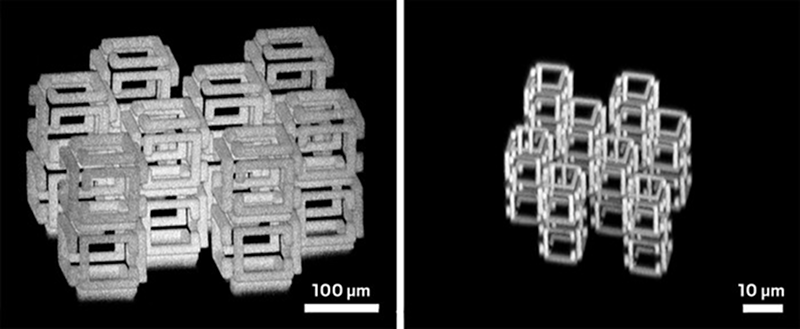If you think about 3D printing, the ultimate goal would be to lay down specific atoms or molecule and build anything. Despite a few lab demonstrations at that scale, generally, it is easier to print in the macro scale than the micro. While it won’t get down to the molecule level, implosion fabrication is a new technique researchers hope will allow you to print large things and then shrink them. The paper describing the process appeared in Science. If you don’t want to pay your way through the paywall, you can read a summary on NewScientist or C&EN. Or you can scour the usual sources.
The team at MIT uses the same material that is found in disposable diapers. A laser traces patterns and the light reacts to a chemical implanted in the diaper material (sodium polyacrylate). That material can swell to many times its normal size which is why it is used in diapers. In this case, though, the material is swollen first and then reduced back to normal size.
Using this process has resulted in features as fine as 10 nanometers. If your 3D printer is well-tuned you might do 0.1 mm layer heights. A 10-nanometer structure is 10,000 times smaller than that.
Oddly enough, the process is the reverse of a process used to “zoom up” brain tissue samples for examination. The technique doesn’t require too many specialized tools, although you do need a “two-photon laser” which is not as exotic as it sounds and is used in fluorescence microscopy.
The real issue, of course, is going to be how repeatable and predictable the scaling is. Usually getting higher print resolutions means a finer nozzle, but this is an entirely different concept.

















https://www.nffa.eu/offer/lithography-patterning/installation-1/two-photon-lithography/
https://en.wikipedia.org/wiki/Multiphoton_lithography
“The team at MIT uses the same material that is found in disposable diapers.”
Disposable prints to go with the cheap, disposable printers. “Hey my print failed!” *throws printer in trash*
Sodium polyacrylate has fairly poor physical properties (strength) though once hydrated. There are more hydrogel like chemistries that can have some strength and there are other hydrogels at least that can have considerable strength. Not sure if sodium polyacrylate based hydrogels have managed to achieve this or not?
Getting this to shrink repeatably across considerably different geometries is likely going to be a big challenge as well. Might be computationally solvable though?
Probably takes some time to shrink as well unless you accelerate things in a higher temperature environment?
Reminds me of those figures that were miniature and you put in water to grow full size slimy. Was that gremlin’s or something like those? I’m thinking you print those full size and then they shrink?
From the photo at the top, I thought Silicon Graphics was getting into 3D printing.
Any elongated solid will shrink when heated to temperatures near the melting point of its material, due to its surface tension. Perhaps that could be used to shrink structures made of identical tiny beams.
Remember Shrinky-Dinks? Writing on them before baking would shrink the writing smaller than most people could write, but it was still legible.
Combine this with the availability of whole sheets of shrinky-dink material, and the tendency of high-school teachers to allow “one 3×5-inch card” of notes on certain exams, and I think you see where this is going.
Or writing on heat shrink tubing and then shrinking it.
1200 dpi printers and subpixel fonts LOL
“the ultimate goal would be to lay down specific atoms or molecule and build anything”
Nope!
That would be a lofty goal but not the ULTIMATE one.
Many elements are still rare and/or expensive. An ULTIMATE printer would print in subatomic particles derived from atoms of common, inexpensive elements thus allowing it to produce things made of any desired kind of atom cheaply.
Ok.. there you go… I just gave you a goal. Now go get inventing!